ISSN ONLINE(2278-8875) PRINT (2320-3765)
ISSN ONLINE(2278-8875) PRINT (2320-3765)
R.Suneeth1, P.Usha2
|
| Related article at Pubmed, Scholar Google |
Visit for more related articles at International Journal of Advanced Research in Electrical, Electronics and Instrumentation Engineering
In home appliances and in small scale industries, single phase induction motors are commonly used. Recently remarkable efforts have been made in adjustable speed - single phase induction motor drives (SPIMD’s). Different types of PWM strategies have been used in speed control of SPIMD’s, most widely sinusoidal PWM & space vector PWM strategies. Various converters technologies are taking a place in SPIMD’s because of its low cost. The proposed project describes the several PWM strategies with an AC chopper to control the speed of single phase induction motor. Asymmetrical PWM technique has been used to operate the power electronics switches (IGBT) of an AC chopper. The main objective of this project is to maintain the speed of the single phase induction motor constant at different load conditions by using Asymmetrical PWM technique, which reduces the harmonic contents in motor current and increasing the motor efficiency. The simulation is carried out in MATLAB/SIMULINK with a Split Phase Induction Motor, where the motor is operated in normal PWM strategy, Hysteresis PWM strategy. The hardware is designed for the Asymmetrical PWM technique and results have been discussed.
Keywords |
| AC Chopper, Speed control, Asymmetrical PWM and THD. |
INTRODUCTION |
| A large number of motors are being used for general purposes in our surroundings from house-hold equipments to machine tools in industrial applications. The electric motor is now a necessary and indispensable source of power in many industries. The function and the applications of these motors are wide-ranging. For the many applications, the speed control of the motor plays a major role, which can be done using a wide range of control strategies. |
| The purpose of a motor speed controller is to take a signal representing the demanded speed, and to drive a motor at that speed. The controller may or may not actually measure the speed of the motor. If it does, it is called a Feedback Speed Controller or Closed Loop Speed Controller, if not it is called an Open Loop Speed Controller. Feedback speed control is better, but more complicated, and may not be required for a simple design. |
| Generally speed control of the motor can be achieved by varying the input parameters of the motor such as current, voltage etc. This can be achieved by various methods such as field control method, armature control method, Ward- Leonard method etc for DC motors and AC motors. |
| Now a day, by the improvement of the power electronics devices, the flow of power to the motor is controlled by the switching action of the power switches (MOSFET, IGBT, IGCT etc). The nature of the speed control requirement for an industrial drive depends upon its type. Some drives may require continuous variation of speed throughout the operation, which ranges from zero to full speed, or a over a portion of the range. For most of the drives, however a control of speed within the range of ±10% of rated speed may be suitable. |
| The existing methods for the speed control of induction motor are voltage control, frequency control, vector control, changing stator poles, rotor resistance, doubly fed motor, Kramer circuit etc are mentioned in the reference [1]. |
| In the reference [2] recently remarkable efforts have been made in speed control of single phase induction motor (SPIMD) drives. In the reference [3] different types of PWM strategies have been used for speed control of induction motor drive. By using PWM strategies, in the reference [4][5] inverter is used to drive the speed of induction motor, AC choppers are used in the reference[6][7] for the speed control of induction motor. |
| In the reference [3][8][9] Ac chopper are used to obtain variable rms voltage from fixed voltage and frequency sources. It is used in applications such as light dimmers, industrial heating furnaces. In this paper by using AC chopper [7], speed control of induction motor is achieved. The input to the AC chopper is pure sinusoidal voltage and the output of the AC chopper i.e. chopped voltage is given to the Induction Motor as the input. By varying the pulses given to the AC chopper the output voltage of AC chopper varies and by this way speed of induction motor is achieved. |
| Generally for the speed control of induction motor drive [4] [5] inverters are used. For the inverter, a separate DC source or rectifier (for converting AC to DC) is required, which increases the size of the whole system. Also for both single phase and three phases Induction motor control, a three leg inverter is used, which increases the number of components and design complexity will be more. Thus in this paper, AC chopper is implemented to control the speed of single phase induction motor by using [3] asymmetrical pwm method. |
II. SPEED CONTROL OF INDUCTION MOTOR BY AC CHOPPER |
| Conventional methods for starting and speed control of single-phase induction motor need often quite expensive external electrical equipment. Moreover, they require mechanical switches, which are the most troublesome parts. These switches suffer from mechanical wear, which affects the motor performance. Electronic methods based on using a triac in series with the stator main winding or using four triac in a bridge topology has been suggested to control the speed of the motor. |
| Starting is still done by a capacitor in with the auxiliary winding. In the literature many authors have suggested and analyzed the performance of single-phase induction motors fed from inverter circuits with space vector pwm. In this case, either single-phase inverter is used with permanent capacitor motors or two phase inverter is used when the capacitor is omitted. Both methods need complicated circuits with high cost. However, AC chopper seems to be an acceptable solution when a wide range of speed control is required. |
| AC chopper is the advance method of the triac which are used to obtain variable RMS voltage from fixed AC course. It is used in the application such as light dimmers, industrial heating furnaces and induction motor speed controllers. The different type of pwm technique such as conventional pwm, asymmetrical pwm, symmetrical pwm etc, is used to drive the AC Chopper. The hysteresis pwm technique offers a reasonably clean output voltage waveform at high power factor and less harmonic distortion factor of the motor current. The fig 1 shows the basic arrangement of the AC chopper circuit. |
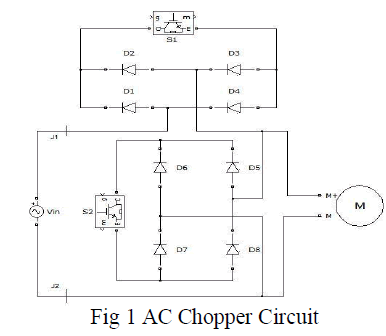 |
| The chopper circuit is feed by a sinusoidal supply directly from the mains at 50 Hz, without a preliminary ac-dc conversion. The main working principle of chopper circuit can be classified into two modes |
| 1) It energies the load at any level of sinusoidal voltage wave. |
| 2) It demagnetizes the load through a freewheeling system. |
| The chopper acts like a converter, particularly as an AC-AC converter and works with any inductive-ohmic load. The above circuit as shown in fig 1 is based on the following parts |
| ïÃâ÷ Motor M and IGBT S2 (freewheeling switch) together with the diodes D5 ,D6 ,D7 and D8 forms current freewheeling path. |
| ïÃâ÷ Another part which is composed of IGBT S1 (main switch) with diodes D1 ,D2 ,D3 and D4 altogether energize the load. |
| ïÃâ÷ The opto-isolator (4n25) provides the isolation between the low voltage side and high voltage side (i.e. between microcontroller and ac-chopper respectively), and also provides the gating signal deriving from the PWM generator to the main and freewheeling switches of AC chopper. |
| ïÃâ÷ PWM generator uses ATMEGA32 micro controller IC. |
| In order to avoid short circuit of the mains through switches S1 and S2, the switches always work in complementary manner. S1 is ON, S2 must be OFF and vice-versa |
| For example, if the line voltage at J1 is positive with respect to J2, at switch S1. The switch S1 turns ON. In mean time the switch S2 is OFF instantaneously. In this condition, current is positive at J1 (it goes into J1 and comes out from J2,) it will flow through D1, S1, D3 and motor. Conversely if current is negative at J1 (it goes into J2 and comes out from J1) it will flow through motor, D2, S1 and D4. |
| When main switch S1 is OFF, S2 turns ON instantaneously this enables freewheeling current flows through S2 |
III. SIMULATION OF SINGLE PHASE INDUCTION MOTOR |
| The motor parameters are found by the no-load test and blocked rotor test of single phase induction motor. The motor parameters are as shown in the fig. 2. |
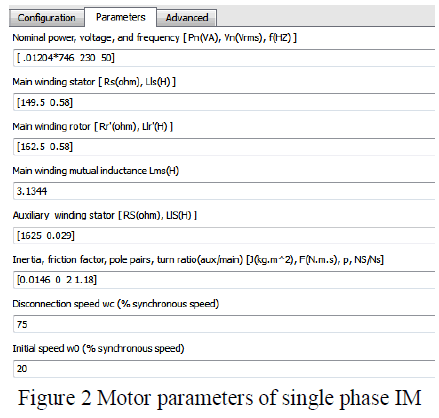 |
| Simulation of speed control of single phase induction motor is carried out in two different control techniques are shown below. |
| 1) PWM- Pulse Width Modulation control |
| 2) HPWM- Hysteresis (Asymmetrical) Pulse Width Modulation control |
| The simulation is carried out in SIMULINK, where the Split-phase induction motor is considered for simulation because of unavailability of shaded pole induction motor in SIMULINK. The speed-torque characteristics of Splitphase motor are same as shaded pole motor, hence the Split-Phase motor is considered for the rest of the simulation. |
| Fig 3 shows the circuit diagram of speed control of Induction motor through AC Chopper in PWM technique. As the PWM technique is the open loop method where the MOSFET’s are controlled through the PWM generator, the respective change in the speed of motor will not change the control of the switches and at certain increase of load will not be sustained by the motor. This disadvantage lead to apply the other PWM technique where once the load increases the motor sustains or made to work in such a condition. For this, Asymmetrical PWM technique is used. In this method, Hysteresis type of PWM technique is adopted where it creates a Hysteresis band and makes the error signal to lie in that created limit. The error signal will be the signal which is obtained by the comparison of output signal and reference signal. The whole circuit is as shown in figure 4.The motor torque will be compared with the reference signal which is also a sinusoidal signal and error signal will held to ‘relay’ where the bandwidth will be set as shown in figure 5. The output of relay will be pulses, which is fed to the switches, the triggering of AC chopper switches are controlled by the pulses generated through error signal. |
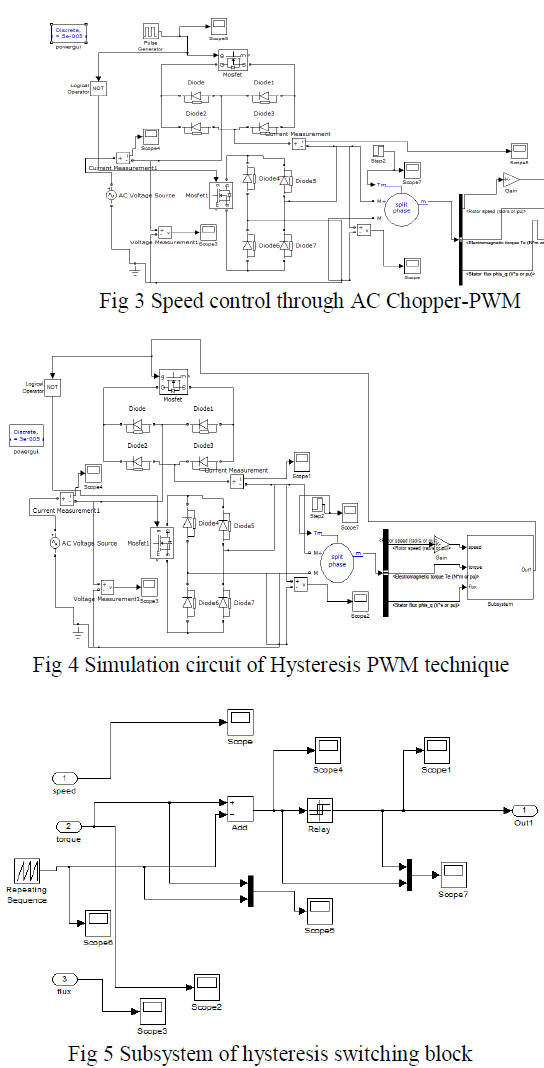 |
IV. HARDWARE MODEL |
| This section deals with the hardware topology of the model and components used in the hardware: microcontroller, AC Chopper circuit, speed sensing and loading system. The entire hardware setup is as shown in above fig 6. It consists of an AC Chopper, Control unit, Induction motor and loading system. |
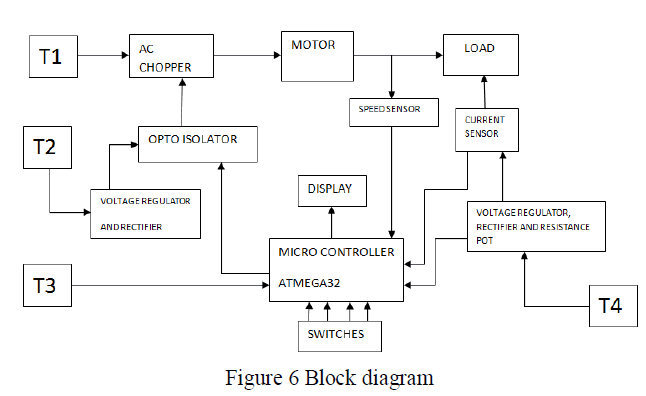 |
| T1, T2, T3 and T4 are the transformers used in the circuit for supply form the mains. IC ATMEGA32 Micro-controller is used for the entire hardware process. |
| The rpm counter is designed to sense the speed of the motor continuously. The rpm counter is built by using reflective optical sensor and a disk with black and white shading as shown in fig 7. The reflective optical sensor includes infrared emitter and photo transistor in a single package (TCRT5000) |
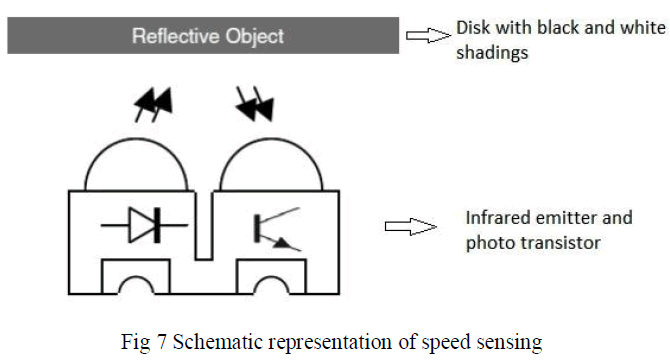 |
| The reflective object is made up of disk with equiv-distance black and white shading (30 each) which is connected to the motor shaft. When supply is given to the motor, it starts rotating which in-turn rotates the disk. When the supply is given to the reflective optical sensor, the infrared emitter emits the light radiation which hits the reflective object (white shadings) and reflects back. The reflected ray is observed by photo transistor which sends the signal to the microcontroller. |
| The obtained signal is given to the micro-controller and it is used for calculating the rpm by using this formula in program. |
 |
| The Induction motor is loaded by using the DC machine. The DC motor is coupled to the induction motor shaft. When the supply is given to the DC machine, it gets energized and tries rotates in opposite direction to the Induction motor. Due to this the Induction motor gets loaded and its speed reduces. The DC machine which is acting as the load to Induction motor is controlled by a switch, for which a potentiometer is connected in series for varying the speed of the DC machine, so that the Induction motor gets loaded and its speed also varies. The load torque of the Induction motor is calculated by using the formula, |
 |
V. RESULT AND DISCUSSION |
| Hysteresis (Asymmetrical) PWM strategy is carried by considering the reference signal, where the output torque signal is compared with the reference signal and error signal is generated. Based on this error signal and by using the relay, gating pulses are generated and fed to the AC chopper switches to produce corresponding chopped voltage and current as shown in figure 8. |
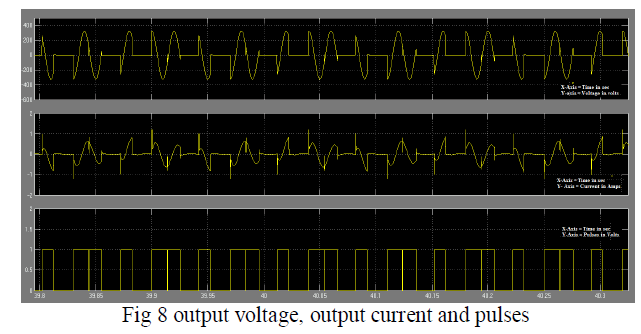 |
| Here these switches will control the input voltage to the motor, which in turn controls the speed of the motor. The resultant waveform of speed is as shown in figure 9.when the load is applied the speed decreases and it made constant. |
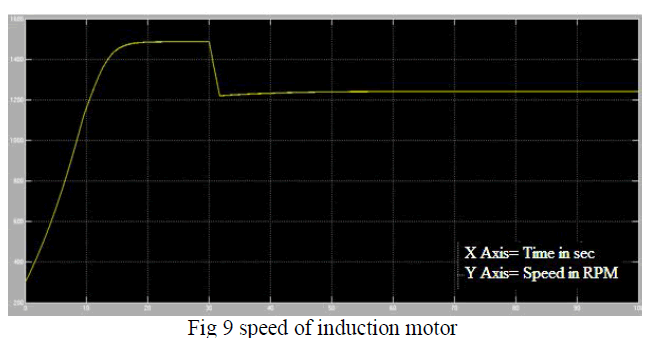 |
| For the same circuit a load has been applied in steps and results has been tabulated which is given in Table 1. From results we can conclude that in HPWM method the speed has maintained constant even there is a long variation of applied step load, once the load reaches 0.15 N-m the speed falls to very low value. |
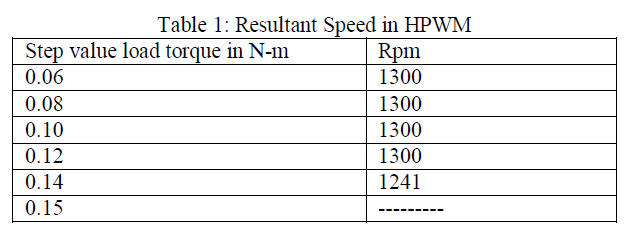 |
| Total Harmonic Distortions are calculated by considering the output voltage and current waveforms, 500 cycles are considered for the calculations at 50Hz frequency and at 30 to 40 seconds and above 40. The resultants are tabulated in table 5.4 for Normal PWM and Hysteresis (asymmetrical) PWM. |
 |
| The asymmetrical PWM method is used in hardware model. The motor is made to run at set speed by giving the instructions through the microcontroller with the help of keys. For the set speed of 550 rpm, the chopped output voltage of the AC chopper which is given to the motor at loaded condition is shown in figure 10. |
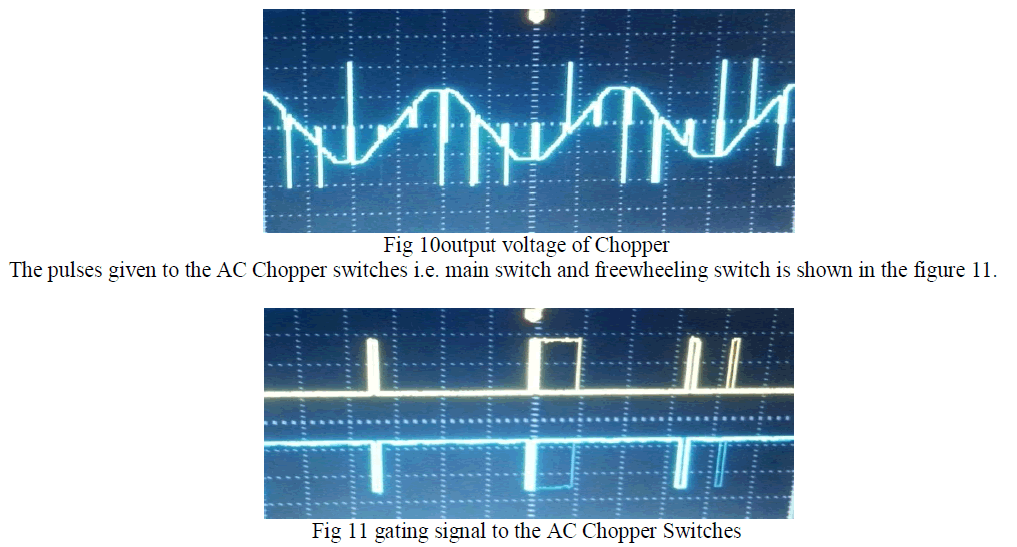 |
 |
VI.CONCLUSION |
| Generally for the speed control of induction motor drives inverters are used, but in this project AC chopper is implemented to control the speed of single phase induction motor. By implementing the Asymmetrical PWM method the load with stand capacity of the motor can be improved and the Total Harmonic Distortion (THD) in motor output current will be reduced when compared to other traditional PWM techniques. |
References |
|